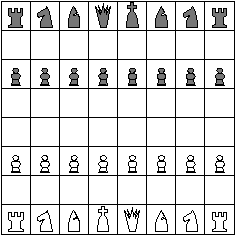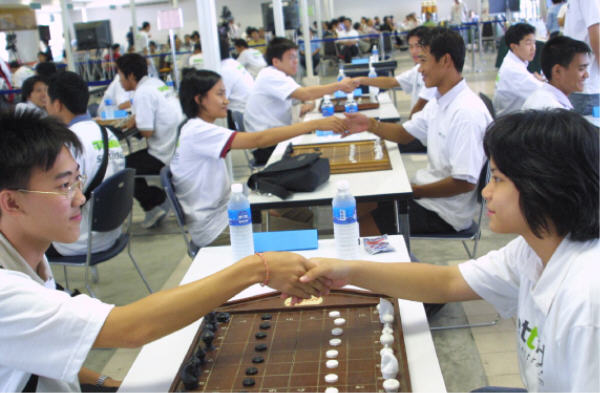Makruk
Thai Chess
This is the variant of chess which is most played in Thailand, where it has a large number of players (Pritchard mentions an estimate of two million Thais who at least know the rules of the game, and there are other mentions of millions of players of this game, all from Thailand.)
Rules
The game is played on an uncheckered board of 8 by 8 squares. The pieces have large similarities to those of the (for us) orthodox chess game, and to make it from the description easy to play with chess game with a normal set of pieces, I will describe pieces with names of their `usual' chess equivalent.
Opening setup
The opening setup is very similar to that of orthodox chess, with the following differences: the positions of white king and queen are reversed, and all pawns are on the third and sixth row. So, the setup is as follows:
 White:
White:
King d1; Queen e1; Rook a1, h1; Knight b1, g1; Bishop c1, f1; Pawn a3,
b3, c3, d3, e3, f3, g3, h3.
Black:
King d8; Queen e8; Rook a8, h8; Knight b8, g8; Bishop c8, f8; Pawn a6,
b6, c6, d6, e6, f6, g6, h6.
Moves
The king, rook, and knight move as in orthodox chess, except that castling does not exist in this game.
The queen moves one square diagonally.
The bishop moves one square straight forward or one square diagonally.
The pawn moves as a normal pawn, but may not make a double step on its first move. When it reaches the sixth row, it promotes to a (Makruk) queen.
Other rules
Object of the game is to mate the opponents king. Stalemate is a draw. Also, when a player has no rook, bishop, or knight anymore, the other player must mate him within a certain number of moves, depending on how many `big' pieces the player has, otherwise the game is declared a draw. The precise numbers are omitted here (also, my sources on this seem to contradict - is there a native player of this game who can provide full information on this topic?).
Additional information
The original names for the pieces are:
- King: Khun - leader. The Khun was the lowest rank of conferred nobility in the Siamese court system (as opposed to inherited nobility).
- Queen: Met - Pit or fruitstone. This is the kerner of a fruit, like a cherry.
- Bishop: Khon or Thon - Mask. The same word means a kind of classical Thai royal drama, using such masks.
- Knight: Ma - horse
- Rook: Rua - boat
- Pawn: Bia - cowry shell. Indeed cowry shells were formerly used for pawns in Thai sets, as well as a unit of very small money. You can take this as: pawns equal small change.
In some cases, for pawns cowry shells are used, who are turned over upon promotion. Similarities of this game, both with Chaturanga or Shatranj, and Shogi are remarkable. Last century, special first moves for king and queen were allowed (the king could make a knight move his first move, and the queen could move two squares diagonally on her first move.) This practice seems to be no longer in use currently. For additional information, reader can e.g., consult The Encyclopedia of Chess Variants which has two pages on this game, including sample games and Thai notation.
A photo of a Matruk tournament
 Makruk is very popular in Thailand. The annual tournament of Thai Chess
this time in spring 2006 at the Thailand Stock Exchange (SET) at
Bangkok.
Makruk is very popular in Thailand. The annual tournament of Thai Chess
this time in spring 2006 at the Thailand Stock Exchange (SET) at
Bangkok.
Photo: courtesy of SET Bangkok
A few links
- Thai Chess Club. Webpage of a chess club of a school in Thailand, with photo's and rules. (Link.)
- Tim Krabbe's WWW page on his experiences with Makruk. Tim Krabbe is a Dutch chess player and journalist. (Link.)
- Photo's of Makruk set.
Written by Hans Bodlaender. With thanks to Jay Griffith for noting a grammatical error, to John Kewley for informing me about a link, and to Don Walsh for his information on the names of the pieces and their meaning in Thai. René Gralla sent me the photo of the tournament at the Thailand Stock Exchange; we thank the SET for allowing us to use this photo. Legend of photo by René Gralla.
WWW page created: 1995. Last modified: May 17, 2007.